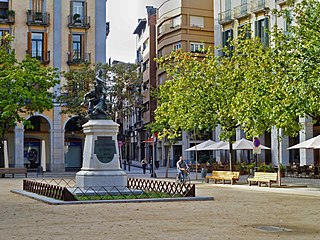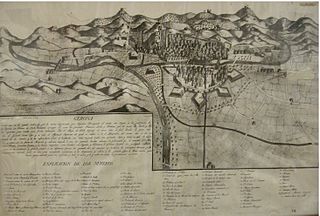
The Peninsular War (1807–1814) was the military conflict fought in the Iberian Peninsula by Spain, Portugal, and the United Kingdom against the invading and occupying forces of the First French Empire during the Napoleonic Wars. In Spain, it is considered to overlap with the Spanish War of Independence. The war started when the French and Spanish armies invaded and occupied Portugal in 1807 by transiting through Spain, and it escalated in 1808 after Napoleonic France occupied Spain, which had been its ally. Napoleon Bonaparte forced the abdications of Ferdinand VII and his father Charles IV and then installed his brother Joseph Bonaparte on the Spanish throne and promulgated the Bayonne Constitution. Most Spaniards rejected French rule and fought a bloody war to oust them. The war on the peninsula lasted until the Sixth Coalition defeated Napoleon in 1814, and is regarded as one of the first wars of national liberation. It is also significant for the emergence of large-scale guerrilla warfare.

The Battle of Uclés saw an Imperial French corps led by Marshal Claude Perrin Victor attack a Spanish force under Francisco Javier Venegas. The French easily crushed their outnumbered foes, capturing over half of the Spanish infantry. Uclés is located in the province of Cuenca 15 kilometres (9.3 mi) east of Tarancón and 100 kilometres (62 mi) southeast of Madrid. The action occurred during what is called the Peninsular War in English-speaking countries and the Spanish War of Independence in Spain. The war was part of a larger struggle known as the Napoleonic Wars.

The third siege of Girona occurred in northern Catalonia, Spain from 6 May to 12 December 1809, during the Napoleonic Wars. A significant event of the Peninsular War, France's Grande Armée lay siege to the town of Girona for seven months. Girona was strategically important because it controlled the main road between France and Spain.

André-Louis-Elisabeth-Marie Briche was a French General of the First French Empire who saw action during the Peninsular War. He was Colonel of the 10th Regiment of Hussars between 1806 and 1809, before being promoted to general of brigade. He led the French Hussars as they charged the Spanish army's left flank at the Battle of the Gebora, and attacked the village of Albuera, along with Nicolas Godinot's infantry, at the Battle of Albuera on 16 May 1811.

The blockade of Barcelona, from August to December 1808, was the failed attempt by Spanish troops to recapture the French occupied Barcelona during the Peninsular War.

François Xavier de Schwarz or François-Xavier-Nicolas Schwartz was born in Baden but joined the French army in 1776. He became a cavalry officer during the French Revolutionary Wars, fighting with the 2nd Hussar Regiment in numerous actions including Jemappes, Fleurus, and Neuwied. After being captured in an abortive invasion of Ireland, he was promoted to command the 5th Hussar Regiment. He led the unit in the War of the Second Coalition, most notably at Hohenlinden and in the subsequent pursuit of the Austrians.
Anne Gilbert de Laval or Anne-Gilbert Laval or Anne Guilbert de La Val became a general officer during the French Revolutionary Wars and led a division in the Napoleonic Wars. Like many other officers, he saw rapid promotion during the French Revolution. He commanded a demi brigade beginning in 1794. He fought in numerous actions during the 1796 campaign in Germany, including the battles of Ettlingen and Neresheim.

The Battle of Cardadeu on 16 December 1808 saw an Imperial French corps led by Laurent Gouvion Saint-Cyr assault a Spanish force commanded by Juan Miguel de Vives y Feliu and Theodor von Reding. Saint-Cyr won the engagement by forming most of his troops into gigantic attack columns and smashing through the Spanish lines. Cardedeu is located 17 kilometres (11 mi) northeast of Barcelona, Spain. The action occurred during the Peninsular War, part of the Napoleonic Wars.

The Battle of Girona on 20 and 21 June 1808 saw an Imperial French division led by Guillaume Philibert Duhesme try to overrun a Spanish garrison commanded by Lieutenant Colonels O'Donovan and O'Daly. The French assault failed and the attackers withdrew. Girona is located about halfway between the Franco-Spanish border and Barcelona on the Autovía A-7. The action occurred during the Peninsular War, part of the Napoleonic Wars.

The second siege of Girona was the second unsuccessful French attempt to capture the city of Girona during the Peninsular War, part of the Napoleonic Wars.

The siege of Roses or Siege of Rosas from 7 November to 5 December 1808 saw an Imperial French corps led by Laurent Gouvion Saint-Cyr invest a Catalan and Spanish garrison commanded by Peter O'Daly. After a siege lasting a month in which the haven and town of Roses was captured and the nearby Trinity Castle invested by over 13,000 French and Italian infantry, artillery and cavalry with heavy siege trains on the hills above, the Citadel was surrendered to the Napoleonic forces. Roses (Rosas) is located 43 kilometres (27 mi) northeast of Girona, Catalonia, Spain. The action occurred during the Peninsular War, part of the Napoleonic Wars.
Juan Miguel de Vives y Feliu was a Spanish general who commanded a division during the French Revolutionary Wars and briefly led an army in the Napoleonic Wars. He was described as a native of Girona. In 1794 he capably led a division against the French in the War of the Pyrenees. He led his division at the battles of Boulou and the Black Mountain in the eastern Pyrenees. In 1796 he was posted to Cartagena and in 1799 he became Captain General of Mallorca.

The Battle of Molins de Rei or Battle of Molins de Rey or Battle of Molins del Rey saw an Imperial French corps led by Laurent Gouvion Saint-Cyr attack a Spanish army temporarily led by Theodor von Reding and the Conde de Caldagues because its commander Juan Miguel de Vives y Feliu was absent. Saint-Cyr outmaneuvered his opponents, distracting them with a false attack in front while sending the bulk of his force across Llobregat River in a turning movement around the Spanish right flank. The Spanish defensive lines crumbled and the French captured 1,200 soldiers, all the Spanish artillery and Caldagues himself. The Peninsular War engagement was fought near Molins de Rei, located 15 kilometres (9 mi) west of Barcelona, Catalonia, Spain.

The evacuation of La Romana's division in August 1808 was a military operation in which a division of troops belonging to the Kingdom of Spain and commanded by Pedro Caro, Marquis of La Romana defected from the armies of the First French Empire. The Spanish troops were part of the Imperial forces in Denmark, which were under the leadership of Marshal Jean-Baptiste Bernadotte. Most of the Spanish troops were successfully spirited away by the British navy and shipped to Santander, Spain to fight against France in the Peninsular War.

The siege of Figueras, which lasted from 10 April to 19 August 1811, saw the Spanish garrison of Sant Ferran Castle led by Brigadier General Juan Antonio Martínez defend against an Imperial French force commanded by Marshal Jacques MacDonald and his deputy Louis Baraguey d'Hilliers. Martínez and his men held out much longer than expected but were eventually starved into surrendering the fortress, which was near Figueres. The action occurred during the Peninsular War, part of the Napoleonic Wars.

In the Battle of Montserrat a force of Spanish irregulars led by Joaquín Ibáñez, Baron de Eroles defended Montserrat Mountain against two Imperial French divisions under the command of Marshal Louis Gabriel Suchet. The minor action occurred during the Peninsular War, part of the Napoleonic Wars. The battle was fought near the Santa Maria de Montserrat Monastery, which is located on the mountain 36 kilometres (22 mi) northwest of Barcelona, Catalonia, Spain.

The Spanish Army of the Peninsular War refers to the Spanish military units that fought against France's Grande Armée during a period which coincided with what is also termed the Spanish War of Independence.

Giuseppe Federico Palombini or Joseph Friedrich von Palombini became an Italian division commander during the Napoleonic Wars. He joined the army of the Cispadane Republic in 1796 and fought at Faenza in 1797. He became commander of a dragoon regiment in 1798. He became commander of the Napoleone Dragoons, of the Cisalpine Republic army, in 1802. He fought as an ally of the French at Kolberg and Stralsund in 1807. He married the daughter of Jan Henryk Dąbrowski (Dombrowski) in 1806.
Juan de la Cruz Baget y Pamiés was a lawyer and commanding officer of the Catalonian somatenes and miqueletes during the Peninsular War.
Raimundo Caldagues y Remond, Count of Caldagues was a French military commander of the Spanish army who distinguished himself leading the relief force at the second siege of Girona. He was promoted to field marshal the following day.




























